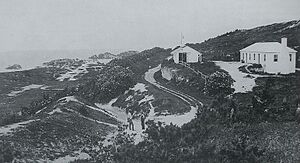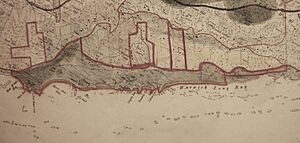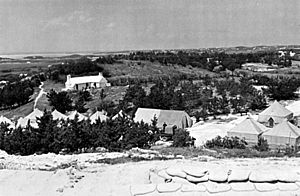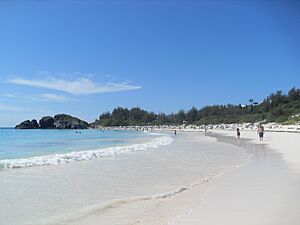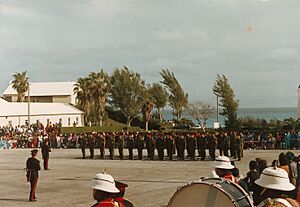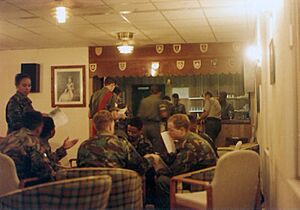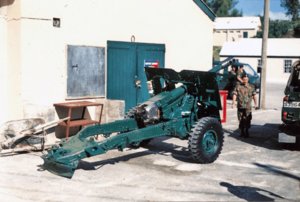Warwick Camp (Bermuda) facts for kids
Quick facts for kids Warwick Camp |
|
|---|---|
| Bermuda | |
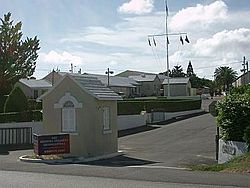
The main gate of Warwick Camp, as it appears today, from the South Shore Road
|
|
|
Location in Bermuda
|
|
| Coordinates | 32°15′25″N 64°48′56″W / 32.25708°N 64.81559°W |
| Type | Barracks Rifle ranges Coastal artillery batteries |
| Site information | |
| Owner | Government of Bermuda |
| Operator | British Army |
| Site history | |
| Built | 1869 |
| Built for | War Office |
| In use | 1869-Present |
| Garrison information | |
| Garrison | Bermuda Garrison |
| Occupants | Royal Bermuda Regiment |
Warwick Camp is a special place in Bermuda that has been used by soldiers for a long time. It started as a place for soldiers to practice shooting and train. Today, it's the main home for the Royal Bermuda Regiment, which is Bermuda's own army.
Contents
Warwick Camp's Early Days
Warwick Camp was built on land the British Army bought in the mid-1800s. This land was along the south coast of Warwick Parish and Southampton Parish in Bermuda. At that time, the army was changing how its soldiers were set up in Bermuda. The main army base was moving to Prospect Camp near Hamilton.
However, Prospect Camp didn't have a good place for soldiers to practice shooting their rifles. So, in January 1869, soldiers from the 61st Regiment helped build the rifle ranges at Warwick Camp. Other soldiers also worked on the Military Road, which is now the South Shore Road.
Warwick Camp included famous beaches like Warwick Long Bay and Horseshoe Bay, which are very popular today. The rifle ranges were set up between these beaches. There was also land north of the road where buildings were later put up. For many years, soldiers didn't live at Warwick Camp all the time. Instead, different army units would use the camp for training and shooting practice throughout the year. This included both full-time soldiers and part-time soldiers, known as Volunteers or Territorials.
Warwick Camp in World War I
When World War I started in August 1914, Bermuda's local army units, like the Bermuda Militia Artillery (BMA) and the Bermuda Volunteer Rifle Corps (BVRC), became full-time soldiers. Even though they had important jobs defending Bermuda, both units wanted to send volunteers to fight in Europe.
The first group of volunteers from the BVRC, nicknamed Bullock's Boys, started training full-time at Warwick Camp in December 1914. Many of these soldiers had joined specifically to go to war. After their training, they were sent to join the Royal Lincolnshire Regiment in Europe, arriving in June 1915. Another group of volunteers from the BVRC was sent the next year.
Warwick Camp in World War II
Between World War I and World War II, permanent buildings called barracks were built at Warwick Camp. Before this, soldiers training there had to sleep in tents.
By 1939, as World War II was about to begin, Bermuda had only one active coastal artillery battery left. This battery, at St. David's Head, had two large 6-inch guns. To protect the Royal Navy's dockyard, which was vulnerable to attack from the sea, a new battery was built at the highest point within Warwick Camp. This new battery also had two 6-inch guns. These guns could help stop enemy ships from getting too close to the dockyard or landing troops on the beaches.
The local soldiers of the BMA operated these guns, and the Bermuda Volunteer Engineers helped with searchlights and communications. Warwick Camp continued to be used for training by all units. It also housed part-time soldiers who were called up for full-time duty during the war.
Before the United States joined the war in December 1941, American soldiers were allowed to come to Bermuda. They were there to guard new base sites that the US was leasing from Britain. One American unit, "B" Battery of the 57th Coast Artillery Regiment, set up two large 155mm artillery guns at Ackermann's Hill within Warwick Camp. These guns were later fixed in place on special mounts. After the war ended, these American guns were removed from Bermuda.
Warwick Camp After World War II
After World War II, the BMA and BVRC became much smaller. Other units were completely shut down. In 1951, the BMA and BVRC (which was renamed the Bermuda Rifles) grew back to their full size. The Bermuda Rifles made Warwick Camp their main base. The coastal artillery guns at Warwick Camp were not used again.
The need for coastal artillery and the whole army garrison soon disappeared. This happened when most of the Royal Navy's dockyard closed in 1951. The last British Army unit left Bermuda in 1957. In 1953, the last coastal artillery battery was taken out of use. The BMA then changed its role to infantry (foot soldiers) and joined the BVRC at Warwick Camp.
Warwick Camp and other military lands were then given to the local government of Bermuda.
Home of the Royal Bermuda Regiment
With no other units using it, the Bermuda Rifles brought all their companies together at Warwick Camp. When the BMA also became infantry soldiers in 1953, they also operated from Warwick Camp. In 1948, it became legal to own cars in Bermuda. This made it much easier for soldiers to travel to Warwick Camp for training, no matter where they lived. In 1965, the BMA and the BVRC joined together to form the Bermuda Regiment.
Since then, Warwick Camp has been the main headquarters and only facility for the Bermuda Regiment. This is a great advantage compared to many part-time army units in other countries. Warwick Camp has large open areas, woods, and full rifle ranges. While some of the longest ranges are no longer used, there are still ranges for different types of shooting practice. There's also a special building with a Firearms Training System (FATS), which lets soldiers practice shooting in simulated battles all year round.
The camp has twelve barrack rooms, which can house a full company of soldiers plus support staff. There are separate buildings for officers and senior non-commissioned officers (NCOs) to stay. There are also large shower areas, a big dining hall, and offices for each company. The main Regimental Headquarters is in its own building, which also holds the armoury (where weapons are kept). The place where ammunition is stored used to be the magazine for the old coastal artillery battery.
Warwick Camp also has other important buildings, like the Regimental Quartermaster's Stores (for supplies) and the Training Wing. There's space to store the two large field guns used by the Bermuda Regiment's ceremonial Gun Troop. There's also plenty of parking for vehicles and storage for the Boat Troop's power boats. At the back of the camp, there are houses for permanent staff and their families. Behind the barracks, there's an assault course with different obstacles for training. Finally, Warwick Camp has a large parade ground, which is important for the Bermuda Regiment's ceremonial duties.
Because of all these facilities, the Bermuda Regiment can do almost all types of training at Warwick Camp. This includes everything from small group battle drills to shooting practice and internal security training, all during their regular training nights or weekend camps.




